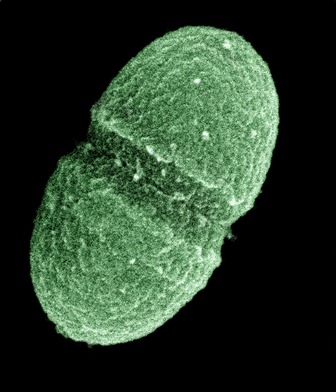User login
SAN FRANCISCO – Intravenous ampicillin is an effective first-line treatment for urinary tract infections caused by vancomycin-resistant enterococci, according to a review from Shands Hospital at the University of Florida in Gainesville.
Although linezolid and daptomycin are sometimes used elsewhere to treat these infections, the hospital staff decided in 2000 to use intravenous ampicillin as the vancomycin-resistant enterococci (VRE) UTI treatment of choice. To prevent resistance, staff there wanted to keep newer, more powerful antibiotics in reserve for more complex infections, Shands infectious disease specialist Ken Klinker, Pharm.D., reported at the annual Interscience Conference on Antimicrobial Agents and Chemotherapy.
The hospital staff reasoned that the high urine concentrations achieved by ampicillin would overwhelm VRE despite possible resistance to the antibiotic, Dr. Klinker said. The approach led to clinical cures in 64 of 70 patients (91%) and microbiologic cures in 40 of the 46 (87%) who had repeat urine cultures.
Patients received a median ampicillin dose of 4 g/day for an average of 4.25 days. When possible, they were then switched to oral ampicillin or amoxicillin.
Ampicillin "seems to work for us and has for many years," said coinvestigator and pharmacist Sam Borgert, also an infectious disease specialist at Shands. "Ampicillin should be considered a viable treatment option for patients with VRE UTI," the investigators concluded when presenting their findings.
Most of the patients had grown out at least 105 CFU/mL on urine culture and were clinically symptomatic. Enterococcus faecium was the predominant pathogen, and it tested almost uniformly resistant to ampicillin.
The median age in the study was 60.5 years and median Charlson Comorbidity Index score was 6. Just over half of the participants were women.
A total of 48 patients had Foley catheters at baseline. Thirty-three of the 34 (97%) who had their catheter exchanged or removed cleared the infection. The cure rate was 57% (8 of 14) among patients who retained their catheter.
"We can’t discern between drug therapy and catheter removal in terms of what drove the results. It’s probably a combination of both," Dr. Klinker said at the conference, which was sponsored by the American Society for Microbiology.
The few patients who failed ampicillin responded to alternate VRE therapies.
Dr. Klinker and Mr. Borgert said that they have no relevant disclosures.
SAN FRANCISCO – Intravenous ampicillin is an effective first-line treatment for urinary tract infections caused by vancomycin-resistant enterococci, according to a review from Shands Hospital at the University of Florida in Gainesville.
Although linezolid and daptomycin are sometimes used elsewhere to treat these infections, the hospital staff decided in 2000 to use intravenous ampicillin as the vancomycin-resistant enterococci (VRE) UTI treatment of choice. To prevent resistance, staff there wanted to keep newer, more powerful antibiotics in reserve for more complex infections, Shands infectious disease specialist Ken Klinker, Pharm.D., reported at the annual Interscience Conference on Antimicrobial Agents and Chemotherapy.
The hospital staff reasoned that the high urine concentrations achieved by ampicillin would overwhelm VRE despite possible resistance to the antibiotic, Dr. Klinker said. The approach led to clinical cures in 64 of 70 patients (91%) and microbiologic cures in 40 of the 46 (87%) who had repeat urine cultures.
Patients received a median ampicillin dose of 4 g/day for an average of 4.25 days. When possible, they were then switched to oral ampicillin or amoxicillin.
Ampicillin "seems to work for us and has for many years," said coinvestigator and pharmacist Sam Borgert, also an infectious disease specialist at Shands. "Ampicillin should be considered a viable treatment option for patients with VRE UTI," the investigators concluded when presenting their findings.
Most of the patients had grown out at least 105 CFU/mL on urine culture and were clinically symptomatic. Enterococcus faecium was the predominant pathogen, and it tested almost uniformly resistant to ampicillin.
The median age in the study was 60.5 years and median Charlson Comorbidity Index score was 6. Just over half of the participants were women.
A total of 48 patients had Foley catheters at baseline. Thirty-three of the 34 (97%) who had their catheter exchanged or removed cleared the infection. The cure rate was 57% (8 of 14) among patients who retained their catheter.
"We can’t discern between drug therapy and catheter removal in terms of what drove the results. It’s probably a combination of both," Dr. Klinker said at the conference, which was sponsored by the American Society for Microbiology.
The few patients who failed ampicillin responded to alternate VRE therapies.
Dr. Klinker and Mr. Borgert said that they have no relevant disclosures.
SAN FRANCISCO – Intravenous ampicillin is an effective first-line treatment for urinary tract infections caused by vancomycin-resistant enterococci, according to a review from Shands Hospital at the University of Florida in Gainesville.
Although linezolid and daptomycin are sometimes used elsewhere to treat these infections, the hospital staff decided in 2000 to use intravenous ampicillin as the vancomycin-resistant enterococci (VRE) UTI treatment of choice. To prevent resistance, staff there wanted to keep newer, more powerful antibiotics in reserve for more complex infections, Shands infectious disease specialist Ken Klinker, Pharm.D., reported at the annual Interscience Conference on Antimicrobial Agents and Chemotherapy.
The hospital staff reasoned that the high urine concentrations achieved by ampicillin would overwhelm VRE despite possible resistance to the antibiotic, Dr. Klinker said. The approach led to clinical cures in 64 of 70 patients (91%) and microbiologic cures in 40 of the 46 (87%) who had repeat urine cultures.
Patients received a median ampicillin dose of 4 g/day for an average of 4.25 days. When possible, they were then switched to oral ampicillin or amoxicillin.
Ampicillin "seems to work for us and has for many years," said coinvestigator and pharmacist Sam Borgert, also an infectious disease specialist at Shands. "Ampicillin should be considered a viable treatment option for patients with VRE UTI," the investigators concluded when presenting their findings.
Most of the patients had grown out at least 105 CFU/mL on urine culture and were clinically symptomatic. Enterococcus faecium was the predominant pathogen, and it tested almost uniformly resistant to ampicillin.
The median age in the study was 60.5 years and median Charlson Comorbidity Index score was 6. Just over half of the participants were women.
A total of 48 patients had Foley catheters at baseline. Thirty-three of the 34 (97%) who had their catheter exchanged or removed cleared the infection. The cure rate was 57% (8 of 14) among patients who retained their catheter.
"We can’t discern between drug therapy and catheter removal in terms of what drove the results. It’s probably a combination of both," Dr. Klinker said at the conference, which was sponsored by the American Society for Microbiology.
The few patients who failed ampicillin responded to alternate VRE therapies.
Dr. Klinker and Mr. Borgert said that they have no relevant disclosures.
AT THE ANNUAL INTERSCIENCE CONFERENCE ON ANTIMICROBIAL AGENTS AND CHEMOTHERAPY
Major Finding: Intravenous ampicillin cures 90% of VRE urinary tract infections.
Data Source: The review involved 70 VRE UTI cases.
Disclosures: The investigators said that they have no relevant disclosures.

